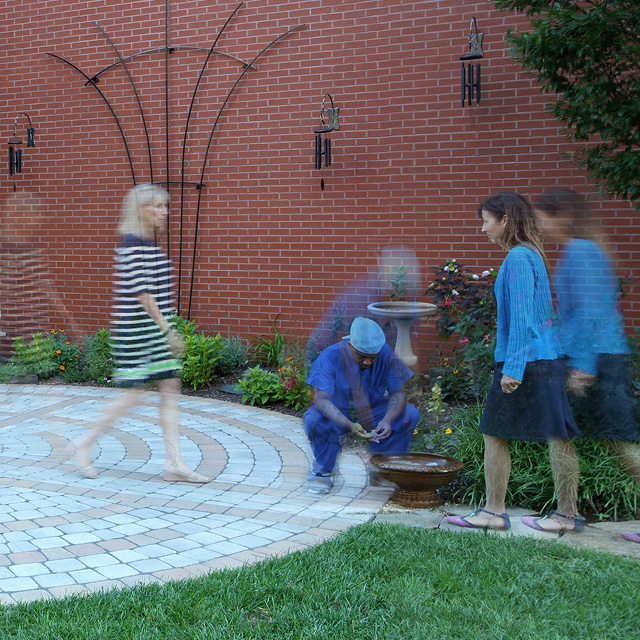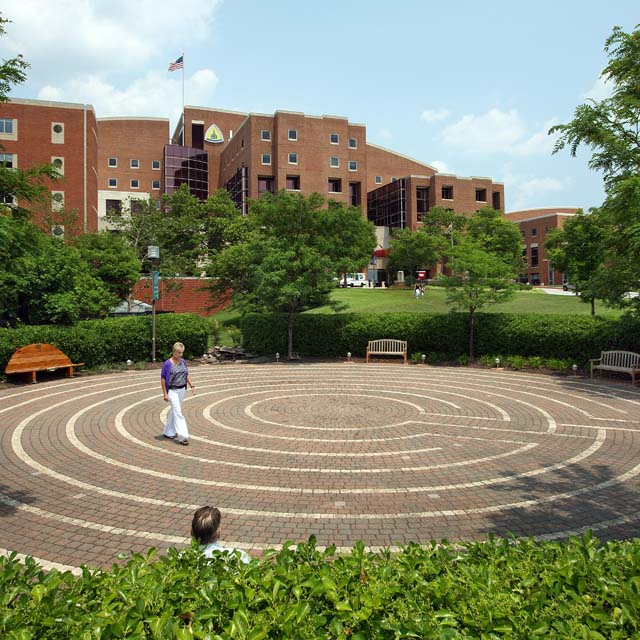As Martin Cortez tends the grounds on Johns Hopkins’ East Baltimore campus, he works an ever-changing landscape designed to lift the spirits of the thousands of employees, patients and family members who enter The Johns Hopkins Hospital every day.
A maintenance mechanic with the hospital, Cortez commutes from Hyattsville, Maryland. While clinicians take care of their patients, Cortez mulches and prunes and clips, and plants — making places for new vegetation to flourish.
“When you like what you do, you do your best,” he says. “I like to make the place look beautiful. I’m looking all the time for little details that can make it look great.”
Each morning, he begins his day at the hospital entrance on Orleans Street, which is marking its 10th anniversary. The landscaped grounds of the Zayed-Bloomberg clinical building complex began to serve as the first impression of The Johns Hopkins Hospital for visitors and employees on April 29, 2012.
Now, they seek out benches in a carefully planned series of gardens and green spaces tied together by walkways. Reflecting pools, sweetgum trees, ornamental grasses, hydrangeas, roses and a variety of seasonal flowers provide a soothing place to think, meditate and relax.
Designed by OLIN, a landscape architecture firm in Philadelphia, the gardens were included early in the new buildings’ design to help relieve the stresses of illness and hospitalization for patients and their families as well as for those who strive to heal them.
“We wanted the gardens to provide a sense of calm — a sense that Hopkins is here to care for you — as you drive into the entry drive from Orleans Street,” says Sally MacConnell, senior vice president of facilities for the Johns Hopkins Health System. “We also wanted the gardens to be visually interesting as you view them from the many windows in Zayed-Bloomberg that overlook the garden.”
MacConnell supervised the planning, design and construction of Zayed-Bloomberg as well as the landscaping of the 6.2 acre property. A decade later, she declares it “lovely.”
Cortez is determined to make sure it stays that way. When he begins his shift at 5 a.m., he cleans the main entrance first: picking up garbage, emptying the trash cans, power washing, sweeping, scrubbing and tending to complaints.
During the height of the COVID-19 pandemic, he also took care of scores of frantic visitors who wanted to know how to get to the testing areas and where to get a vaccine.
“We help. We try to do the best we can,” he says. “That’s what we are here for. To help people.”
During his years at Johns Hopkins, many green spaces have emerged, expanded and changed. The grounds crew tends to the energy conserving green roof atop the hospital MRI building — which is not accessible by the public — as well as the various hospital entrances and ground level areas between buildings.
After an open courtyard became the Armstrong Medical Education Building, a garden with a labyrinth was created along its west wall. The garden honors the anonymous people whose bodies are donated for medical students’ human anatomy course as well as the living volunteers who help with their training.
Chuck McCauley, grounds supervisor for the hospital, recommends also visiting the courtyard garden at the historic Phipps building. Since construction changed the amount of sun exposure, he says the green areas have become a tranquil sanctuary for ferns and other shade plants.
He mentions that the Meyerhoff courtyard now contains dozens of pots with shrubs and flowers for people enjoying an outdoor lunch.
McCauley also praises the slivers of green outside the outpatient center and the views of partially hidden areas that flit through your awareness while hurrying to a doctor’s appointment or a meeting. He says many of those “woodland” scenes are intended to soothe patients who have just had procedures.
Cortez believes the manicured lawns, the flowers and the lush foliage can summon memories to counterbalance the pressures of life in a gritty urban environment. His personal connection extends back to his childhood in El Salvador, when he helped his mother and grandmother sell many of the same flowers — begonias and roses — that he admires in front of the Billings administration building.
A sense of well-being can also come from watching hospital grounds keepers maintain such beauty.
“People love it when we’re out here doing the flowers,” Cortez says. “I think we make it easier for them emotionally.”



